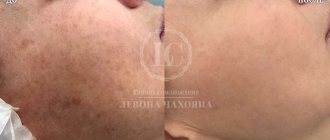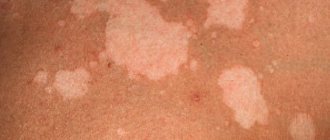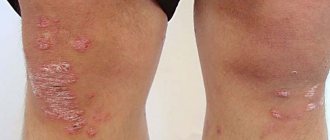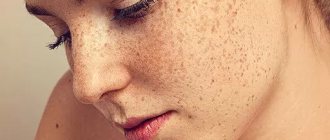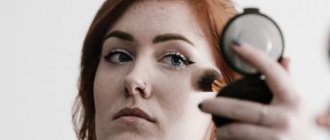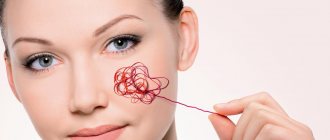Pigment spots on the face and body for a woman often become a cause of psychological discomfort and self-doubt. But in modern cosmetology there are many effective methods for treating age spots that help a woman save her nerves and preserve her image.
Types of age spots
There are several types of age spots:
- Freckles are the most common and safest age spots; they arise due to the inability of a young body to distribute sun tan evenly throughout the skin. During the cold season they disappear and appear again in the spring. With age, the sun tan usually begins to spread evenly and freckles disappear completely.
- Lentigines are age spots on the face, arms, back and shoulders. They appear after 40 years, as a rule, in those places where there were freckles in youth. They reveal their real age, which is why women try to get rid of them.
- Melasma (chloasma) is pigmentation during pregnancy, which manifests itself as a result of hormonal imbalance in the body as a result of bearing a child. Once the hormonal balance is restored, the spots disappear on their own.
- Birthmarks (moles) are age spots that can be congenital or acquired with age. The reason for their appearance is a disruption in the functioning of the skin and the accumulation in one place of cells overflowing with pigment. Moles are considered benign tumors, which under unfavorable circumstances can become malignant.
- Vitiligo is pinkish or milky-white pigment spots that can form at any age. Their exact origin has not yet been clarified by science; it is believed that their appearance is provoked by a failure of the endocrine system.
Causes of age spots
Before choosing stain removal products, you need to understand their type and reasons for their appearance. Skin pigmentation is possible at any age, the most common causes are:
- hormonal changes in the body - pregnancy, prolonged use of certain medications or contraceptives, use of cosmetics of dubious quality;
- age over 40, due to the loss of cells’ ability to stop the production of pigment, menopause can also lead to hormonal imbalance and aggravate the situation;
- gynecological diseases - ovarian dysfunction, inflammatory diseases of the genital organs;
- diseases of the liver and biliary tract;
- dysfunction of the thyroid gland;
- nervous and chronic diseases;
- work in hazardous chemical industries and in workshops with elevated temperatures;
- vitamin C deficiency;
- contact with skin of aggressive substances;
- use of ointments and creams that irritate the skin;
- consequences of injuries of various origins: removal of tumors on the skin, squeezing out acne, use of cauterizing agents, etc.;
- as a result of friction or pressure of any objects (on the body - belts, garters, etc.);
- exposure to sunlight.
The sun plays a huge role in the appearance of age spots. In spring, freckles become the most noticeable; they are scattered across the skin in the form of small oval or round spots. Their peculiarity is that they have a yellowish-brown color and do not merge with each other. To avoid negative sun exposure, facial skin in spring and summer should be protected and try to avoid direct sunlight. When vacationing in the south, you need to select protective products - cream, milk, etc. - individually, depending on the characteristics of your skin. Only in this case can you expect an effect from using the funds. Creams like “tanning without tanning”, etc. will help get rid of age spots that have appeared.
Improperly performed facial skin care procedures can also cause skin pigmentation. For example, hyperpigmentation can be caused by improperly performed facial cleansing, using scrubs and peeling creams without taking into account the time of year. Applying perfumes and other perfumes to exposed skin can also cause skin pigmentation. The essential oils included in their composition increase the skin's sensitivity to sun exposure. The result may be the appearance of photodermatitis followed by pigmentation. The composition of lipstick or blush may also not suit your skin.
Pigment spots often appear during pregnancy. Some women develop chloasma from the very early stages - pigment spots with a sharply defined irregular contour. They last during pregnancy and for some time after childbirth, sometimes they can persist for several years.
When treating freckles and chloasma during pregnancy, only weakly active substances are allowed. Although the duration of treatment increases due to a decrease in effectiveness, the skin does not suffer from the effects of the drugs. When carrying a child, the use of products containing mercury, salicylic acid, green soap and hydroquinone is contraindicated due to the possibility of their negative effects on the mother’s body and the condition of the fetus.
Pigment spots on hands
If pigment spots on the face can be hidden with makeup, and on the legs they can be hidden under tights or trousers, but with the hands it is more difficult; there is nothing to hide the spots on them. A person's true age is often revealed by his hands. The back of the hands is most susceptible to sun exposure; it is there that age-related skin pigmentation begins earlier than on other parts of the body. With age, entire zones of hyperpigmentation may appear on the hands, called “solar lentigo” (liver or age spots). Such lentigo appears in middle age as a result of regular exposure of the skin to solar radiation. Areas of lentigo remain dark, even if the tan on the skin fades. This occurs due to ultraviolet damage to the cells responsible for the production of melanin. Melanocytes located deep in the skin eventually form dark areas called age spots. Despite being harmless at first glance, age spots can cause many aesthetic problems for a woman.
Diagnostics
To identify the presence of age-related pigmentation, a dermatologist only needs a physical examination. To exclude the risk of cancer pathologies and the presence of atypical cells, additional studies may be required:
- blood test for protein tumor markers;
- fibroblast growth factor analysis (heparin-binding proteins);
- analysis of vascular growth factor (platelet growth factor);
- confocal laser scanning microscopy (CLSM).
Symptoms of age spots
The main symptoms of age spots:
- formation on the skin of flat colored zones of light brown, gray, reddish, black colors;
- the spots usually take on an oval shape;
- spots that are located in places that are most exposed to sunlight (on the forehead, arms, shoulders, back, forearms, etc.);
- As a rule, age spots are located in groups;
- skin aging;
- dryness of the epidermis;
- deep wrinkles, creases;
- roughening of the skin.
Pigment spots should be distinguished from, for example, flat moles, warts, and lentigo maligna.
If you experience similar symptoms, consult your doctor
. It is easier to prevent a disease than to deal with the consequences.
How to deal with hyperpigmentation
Today there are many methods that will help even out skin color, but the purpose of one or another method depends on the severity of the problem and goals.
Unfortunately, if a person is predisposed to hyperpigmentation, then making the skin look young and even in color is quite difficult.
In cosmetology they use:
- special masks and creams with whitening effect;
- in some cases, peeling or grinding (acid or laser) is indicated;
- hardware IPL procedures.
Hardware methods are the most effective way to remove the appearance of pigment on the skin.
Treatment of age spots
To remove age spots on the face:
- whitening creams;
- chemical peeling;
- ultrasonic peeling;
- laser facial resurfacing;
- phototherapy.
Whitening creams should be used under the supervision of a cosmetologist. You cannot immediately begin skin treatment with the use of potent creams, since there is a risk of getting the opposite effect - the skin will become even darker. Self-medication can also in some cases lead to dermatitis. Creams containing mercury can only be used after a preliminary test. You need to rub a small amount of cream onto the elbow bend and examine this place in about a day. But even if the testing was successful, you still cannot use such creams all the time, because... mercury is a toxic element.
Creams containing mercury should not be used during pregnancy and breastfeeding, as well as if you have kidney, liver or gum diseases. They should not be applied to damp or hot skin to avoid irritation.
Cosmetologists advise using whitening ointments based on fatty creams that do not contain water, which facilitates the penetration of toxic substances into the body. When using whitening ointments, for the first two weeks it is recommended to use sour milk and lotions to cleanse the skin, since washing with water can enhance the effect of the ointments and cause irritation.
Therapeutic cosmetics are an alternative to creams containing mercury. It contains lactic or citric acid, perhydrol, hydrogen peroxide or salicylic alcohol. The disadvantage of such cosmetics is their short shelf life.
Chemical peeling has become very popular in recent years; the procedure is offered in many beauty salons and aesthetic medicine centers. Peeling helps get rid of various skin blemishes, including dark spots on the face and body. During the procedure, the top layers of skin are removed using a weak solution of acid (glycolic, trichloroacetic or fruit). Essentially, a chemical peel is a superficial burn of the skin, the depth of which depends on the type and concentration of acid used.
The deepest peeling is carried out with phenol, but it is rarely used due to the high risk of scarring on the skin. To eliminate age spots, a medium or weak peeling is usually sufficient, which is selected individually by a dermatocosmetologist. Superficial peeling is carried out in courses of 4-10 sessions, between which there should be an interval of 10-15 days. A more powerful technique is medium peeling, which is carried out using trichloroacetic acid in 1 session or 2-3 sessions with an interval of 1-2 months between them.
The method is relatively inexpensive and virtually painless, with only a slight burning sensation. Redness and swelling of the skin disappears the next day. After the procedure, it is necessary to monitor your face and protect it from exposure to sunlight, under the influence of which the spots may return.
Laser resurfacing can also restore a uniform color to the skin. The laser helps to discolor pigment spots, renew the skin and improve its tone. Modern erbium lasers are used, which make it possible to significantly reduce the depth of thermal damage and shorten the period of postoperative recovery, compared to carbon dioxide methods, by almost 4 times. The disadvantage of the procedure is its high cost.
Ultrasonic peeling involves the introduction of various cosmetics into the previously cleansed epidermis using ultrasound. The usual course of treatment for age spots on the face is 10 sessions once a year.
Phototherapy, reflecting the famous expression “knocks out the fire,” uses intense pulses of light to treat sun spots. Laser radiation is used, the wavelength of which is selected in such a way that it affects only the skin pigment. During the procedure, a slight tingling sensation is possible; slight redness disappears in 1-2 days. After phototherapy, pigment spots disappear or become significantly lighter. 2-3 procedures are carried out with a break of 3-4 weeks. To avoid the reappearance of spots, you should protect your face from sunlight and use sunscreen with a filter of at least 30.
Treatment of age spots with folk remedies
Folk remedies can be used to lighten age spots:
- A whitening mixture made up of 3 drops of rosemary oil, ½ spoon of vinegar, ½ spoon of freshly squeezed lemon juice and 1 teaspoon of horseradish. Apply 1-2 times a day to pigmented areas of the skin with a cotton swab. People with sensitive skin should use the mixture carefully.
- Papaya, the juice of which contains enzymes that can fade age spots. May cause allergic reactions in some people.
- Lotions of apple cider vinegar and onion juice - the mixture is prepared in a 2:1 ratio.
- Rubbing the pigmented areas with fresh cucumber, old kefir, hydrogen peroxide or sour milk are mild remedies, the effect of which becomes noticeable after a few weeks.
If the use of bleaching agents does not help, this means that increased pigmentation may be caused by diseases of the internal organs. Sometimes age spots can indicate the development of skin cancer. If increased pigmentation appears on the body or changes in the appearance of moles, or unpleasant sensations appear in their area, you should consult a doctor.
Prevention of age spots
It is easier to prevent any trouble than to deal with it later. You can avoid skin pigmentation by organizing proper nutrition and following skin care rules. Among the measures to prevent pigmentation of the skin of the face and body:
- ensuring sufficient intake of vitamin C and nicotinic acid (vitamin PP) into the body with foods and in the form of preparations - daily dose of 1.0-1.5 g and 0.03 g, respectively;
- the use of folk remedies to preserve the whiteness of the skin - milk or whey, wiping the facial skin with lemon and parsley juice (in a 1:1 portion) before applying a nourishing cream, etc.;
- sunscreen cosmetics for the face with a high protection factor against UV rays (the labels indicate the SPF sign with a number from 4 to 60; multiplying this number by 15 calculates the time in minutes during which the skin will be protected);
- sunscreen for hands, which should be used after each washing of the limbs, as well as various whitening and exfoliating agents that allow you to soften dull or dry skin of the hands and retexturize it.
This article is posted for educational purposes only and does not constitute scientific material or professional medical advice.
Features of aging hands
Have you heard the banal phrase that hands are the first to reveal a woman’s age? Alas, this is the bitter truth.
Look at the celebrities. If the age on the face can be hidden behind makeup, “beauty injections” and braces, then the hands will reveal it instantly. These wrinkled “chicken feet” with age spots literally scream that the young star is no longer fresh. And, most likely, she is interested in artificial “rejuvenation” rather than natural. If you prolong your youth by activating natural physiological mechanisms, this can be seen both in your face and in your hands. And here the face is not organic, and the hands are old. You can't hide the truth.
But first things first.
Why do hands age faster than your face?
- They are most susceptible to the influence of negative external factors.
In summer, the hands are always exposed to the sun; in winter, they often become hypothermic. And what is the cost of constant contact with household chemicals and mechanical impact! How often do you wash dishes, clean plumbing, do wet cleaning, soak stains, do laundry? Do you always wear gloves? Here is the answer. - The skin of the hands differs in its anatomical structure from the skin of the face.
It has fewer sebaceous glands, which means less lipids are produced that protect against negative external factors. And those lipids that exist are constantly washed away and “corroded” by numerous household chores.There is also lower blood circulation in the skin of the hands. And the vessels give strength, renewal, resistance to external negative factors. The less developed microcirculation, the faster the skin fades.
- We pay less attention to our hands than to our face.
As a rule, we leave taking care of them for later.


